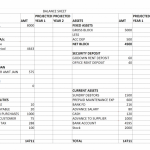- Have any questions?
- 057 21 20 555
- 0100 81 88 681
- almohandes.furniture@gmail.com
What Other Types of Contra Accounts Are Recorded on the Balance Sheet? Chron com
What Other Types of Contra Accounts Are Recorded on the Balance Sheet? Chron com
Content

We also reference original research from other reputable publishers where appropriate. You can learn examples of contra assets more about the standards we follow in producing accurate, unbiased content in oureditorial policy.
- Examples of contra liabilities are Discounts on Bonds and Notes Payable and Short-Term Portion of Long-Term Debt.
- They are categorized as current assets on the balance sheet as the payments expected within a year.
- The depreciation schedule is the amount of depreciation expense that will be recognized each year.
- Sales returned for a refund are posted to the contra account to reduce gross revenue or return on sales.
- Contra asset accounts can be used in a variety of areas, but there are three contra asset examples that you should pay close attention to.
Contra accounts are used to reduce the value of the original account directly to keep financial accounting records clean. Contra equity reduces the total number of outstanding shares on the balance sheet. The key example of a contra equity account is Treasury stock, which represents the amount paid to buyback stock. The book value of an asset is the value of the asset recorded in the company’s balance sheet. Contra accounts are needed for determining the book value of assets held by a company.
Expense Contra Account
The company will book another $10,000 in depreciation expenses during the second year. The accumulated depreciation will increase by $10,000 to $20,000, and the book value will be further lowered to $80,000. It is prepared when there is a reduction in the value of assets due to wear and tear continuous use or when we expect that a certain percentage of accounts receivable will not be received.
Which of the following is a contra asset account?
Answer and Explanation: The correct answer is option a. Accumulated depreciation. The accumulated depreciation account is a contra asset account because it reduces the effective value of fixed assets of a firm.
Reserve for obsolete inventory is a contra asset account used to write down the inventory account if inventory is considered obsolete. Excess, stored inventory will near the end of its lifespan at some point and, in turn, result in expired or unsellable goods. In this scenario, a write-down is recorded to the reserve for obsolete inventory. Whereas assets normally have positive debit balances, contra assets, though still reported along with other assets, have an opposite type of natural balance.
Can You Adjust Retained Earnings GAAP for Intangible Assets?
Businesses use sales returns accounts to track product issues and customer trends. Fixed AssetsFixed assets are assets that are held for the long term and are not expected to be converted into cash in a short period of time. Plant and machinery, land and buildings, furniture, computers, copyright, and vehicles are all examples. A contra account enables a company to report the original amount while also reporting the appropriate downward adjustment. Contra accounts provide more detail to accounting figures and improve transparency in financial reporting.
Accountants use contra accounts rather than reduce the value of the original account directly to keep financial accounting records clean. If a contra account is not used, it can be difficult to determine historical costs, which can make tax preparation more difficult and time-consuming. By keeping the original dollar amount intact in the original account and reducing the figure in a separate account, the financial information is more transparent for financial reporting purposes. The amount for estimated uncollectible accounts is a bad debt operating expense. The allowance for doubtful accounts is the contra account that reduces the accounts receivable to an estimated realizable amount.
Why are contra asset accounts important for businesses?
For example, funds deposited in the bank account and withdrawn are recorded in the Bank account. Depreciation is not directly reduced from the asset so that the historic value/fair value of the asset could be presented in a balance sheet. Suppose a clothing business has sold $50,000 of inventory on credit.
- You don’t have to, yet even a small business will benefit by using the contra asset account for accounts receivable.
- Suppose a company has recorded $100,000 in accounts receivable (A/R) and $10,000 in the allowance for doubtful accounts (i.e. 10% of A/R is estimated as uncollectible).
- Usually, credit balances include items from one of those two natures.
- A contra account is an account that companies use to reduce the value of a related account.
- The amount spent on their purchase is capitalized and treated as assets.
For the purpose of financial statement reporting, the amount on a contra account is subtracted from its parentaccount gross balance to present the net balance. Long-Term Assets are parent accounts that contain the original acquisition cost of fixed assets. Learn why contra accounts, when utilized correctly along with a paired account, are a crucial component of accurate accounting and financial review. By the end of the first-year machinery, the balance will be $100,000, and accumulated depreciation will show $20,000.
This accumulated depreciation account would continue until the asset is disposed of. Accounts receivable result in a cash inflow to an organization when they repay their dues. They are the current assets of a company expected to be realized within 12 months. You can estimate the total to record in the allowance for doubtful accounts based on uncollectible revenue totals from the previous year or you can conservatively estimate the amount.

Is depreciation a contra asset?
Accumulated depreciation accounts are asset accounts with a credit balance (known as a contra asset account). It is considered a contra asset account because it contains a negative balance that intended to offset the asset account with which it is paired, resulting in a net book value.
